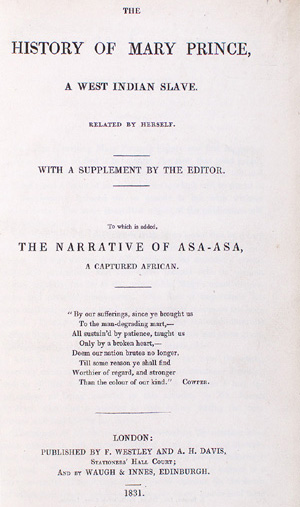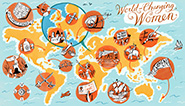| Mary Prince | Caribbean/England | 1788 - ? | Anti-slavery |
 Mary Prince's novel - first edition cover
It is estimated that, by 1800, there were 450,000 slaves in the British West Indies and Britain’s economy was supported by the vast wealth of prosperous slave traders. By the 1830s, however, the slave trade had been abolished and legislation to free all slaves in British dependencies followed soon after in 1833. Anti-slavery campaigns were influential in bringing about this change and the publication, in 1831, of the autobiography of Mary Prince, a female slave from the British West Indies, had a profound impact on these campaigns.
Mary Prince's novel - first edition cover
It is estimated that, by 1800, there were 450,000 slaves in the British West Indies and Britain’s economy was supported by the vast wealth of prosperous slave traders. By the 1830s, however, the slave trade had been abolished and legislation to free all slaves in British dependencies followed soon after in 1833. Anti-slavery campaigns were influential in bringing about this change and the publication, in 1831, of the autobiography of Mary Prince, a female slave from the British West Indies, had a profound impact on these campaigns.
Mary Prince was born into a slave family in Bermuda, around 1788. Her mother was a household slave and when the family who owned them lost money, her mother had no choice but sell Mary at the market-place. For the next 15 years Mary was bought and sold between brutal owners who abused her physically and sexually. In 1815 she was taken to Antigua by her then-owner, John Wood. There she met and married Daniel James, a former slave who had bought his freedom. Since she had not asked permission to marry, she was severely beaten as punishment.
In 1828 Prince was taken by the Woods to London, where escaped from them the same year. She sought help from the Anti-Slavery Society where she discovered that, to keep her freedom, she would not be able to return to her husband in Antigua. After unsuccessfully petitioning parliament for her freedom, she told her life story to abolitionist sympathisers and they published it as ‘The History of Mary Prince, a West Indian Slave, Related by Herself, 1831’. Many readers could not believe the extent of the violence it contained.
The remainder of Mary Prince’s life remains unknown but, in 2007, her contribution to the ending of slavery was recognised when a plaque was unveiled in her honour at the University of London’s Senate House, the site of the house where she lived in 1829.
 This article is part of the world-changing women collection. All the articles in this collection are specially produced for the How women changed the world interactive tour created to reveal the untold stories the history books left out.
This article is part of the world-changing women collection. All the articles in this collection are specially produced for the How women changed the world interactive tour created to reveal the untold stories the history books left out.
You can also view these articles without the interactive feature here.




Rate and Review
Rate this article
Review this article
Log into OpenLearn to leave reviews and join in the conversation.
Article reviews